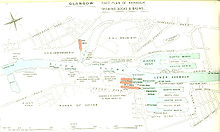
The River Clyde is a river that flows into the Firth of Clyde in Scotland. It is the ninth-longest river in the United Kingdom, and the third-longest in Scotland. It runs through the major city of Glasgow. Historically, it was important to the British Empire because of its role in shipbuilding and trade. To the Romans, it was Clota, and in the early medieval Cumbric language, it was known as Clud or Clut. It was central to the Kingdom of Strathclyde.

Her Majesty's Yacht Britannia, also known as the Royal Yacht Britannia, is the former royal yacht of the British monarchy. She was in service from 1954 until 1997. She was the 83rd such vessel since King Charles II acceded to the throne in 1660, and is the second royal yacht to bear the name, the first being the racing cutter built for the Prince of Wales in 1893. During her 43-year career, the yacht travelled more than a million nautical miles around the world to more than 600 ports in 135 countries. Now retired from royal service, Britannia is permanently berthed at Ocean Terminal, Leith in Edinburgh, Scotland, where it is a visitor attraction with over 300,000 visits each year.

The Fairfield Shipbuilding and Engineering Company, Limited was a Scottish shipbuilding company in the Govan area on the Clyde in Glasgow. Fairfields, as it is often known, was a major warship builder, turning out many vessels for the Royal Navy and other navies through the First World War and the Second World War. It also built many transatlantic liners, including record-breaking ships for the Cunard Line and Canadian Pacific, such as the Blue Riband-winning sisters RMS Campania and RMS Lucania. At the other end of the scale, Fairfields built fast cross-channel mail steamers and ferries for locations around the world. These included ships for the Bosporus crossing in Istanbul and some of the early ships used by Thomas Cook for developing tourism on the River Nile.

John Brown and Company of Clydebank was a Scottish marine engineering and shipbuilding firm. It built many notable and world-famous ships including RMS Lusitania, RMS Aquitania, HMS Hood, HMS Repulse, RMS Queen Mary, RMS Queen Elizabeth and the Queen Elizabeth 2.
John Macgregor (1802–1858) was a Scottish shipbuilder.

William Denny and Brothers Limited, often referred to simply as Denny, was a Scottish shipbuilding company.
Alexander Stephen and Sons Limited, often referred to simply as Alex Stephens or just Stephens, was a Scottish shipbuilding company based in Linthouse, Glasgow, on the River Clyde and, initially, on the east coast of Scotland.

A & J Inglis, Ltd, was a shipbuilding firm founded by Anthony Inglis and his brother John, engineers and shipbuilders in Glasgow, Scotland in 1862. The firm built over 500 ships in a period of just over 100 years. Their Pointhouse Shipyard was at the confluence of the rivers Clyde and Kelvin. They constructed a wide range of ships, including Clyde steamers, paddle steamers and small ocean liners. In wartime, they built small warships, and in the period after World War II, they built a number of whalers.

Robert Napier was a Scottish marine engineer known for his contributions to Clyde shipbuilding.

Thistle was the unsuccessful Scottish challenger of the seventh America's Cup in 1887 against American defender Volunteer.

Shamrock was a racing yacht built in 1898 that was the unsuccessful Irish challenger for the 1899 America's Cup against the United States defender, Columbia.

Neafie, Levy & Co., commonly known as Neafie & Levy, was a Philadelphia, Pennsylvania shipbuilding and engineering firm that existed from the middle of the 19th to the beginning of the 20th century. Described as America's "first specialist marine engineers", Neafie & Levy was probably the first company in the United States to combine the building of iron ships with the manufacture of steam engines to power them. The company was also the largest supplier of screw propellers to other North American shipbuilding firms in its early years, and at its peak in the early 1870s was Philadelphia's busiest and most heavily capitalized shipbuilder.

Valkyrie III, officially named Valkyrie, was the unsuccessful British challenger of the ninth America's Cup race in 1895 against American defender Defender.

Valkyrie II, officially named Valkyrie, was a British racing yacht that was the unsuccessful challenger of the 1893 America's Cup race against American defender Vigilant.

His Majesty's Yacht Britannia was a gaff-rigged cutter built in 1893 for RYS Commodore Albert Edward, Prince of Wales. She served both himself and his son King George V with a long racing career.
The Pusey and Jones Corporation was a major shipbuilder and industrial-equipment manufacturer. Based in Wilmington, Delaware, it operated from 1848 to 1959.
The Maritime history of Scotland involves events including shipping, ports, navigation, and seamen, as well as marine sciences, exploration, trade, and maritime themes in the arts of Scotland.

George Lennox Watson was a Scottish naval architect. Born in Glasgow, son of Thomas Lennox Watson, a doctor at the Glasgow Royal Infirmary, and grandson of Sir Timothy Burstall, engineer and entrant at the 1829 Rainhill Trials.
Events from the year 1893 in Scotland.
Sir James Bell, 1st Baronet, DL JP was a 19th-century Scottish shipping owner and coal-exporter who served as Lord Provost of Glasgow from 1892 to 1896.
















